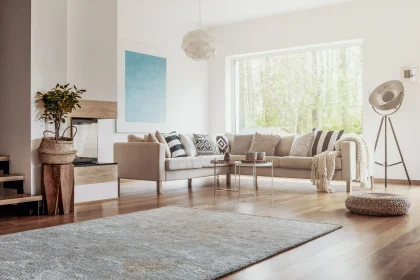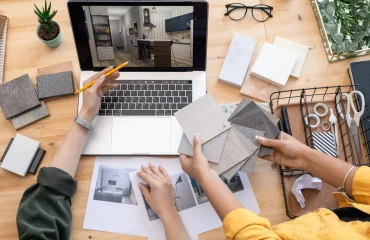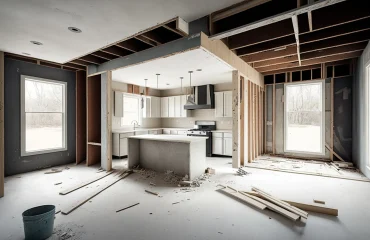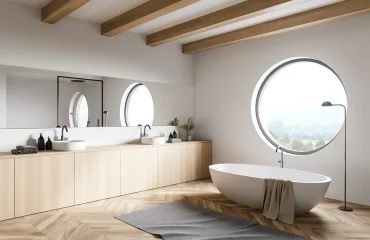
The living room is more than a place to relax – it’s where you entertain guests, enjoy family time and show off your style. But what if your living room feels cramped and cluttered? To make your living room feel more spacious, you don’t necessarily have to knock down walls or move to a bigger house. With a few clever design tricks and some strategic rearranging, you can create a sense of openness and spaciousness in even the smallest space. Here’s how to make your living room feel more spacious and inviting.
- Clutter and simplification: the first step to making any space feel bigger is to declutter. Clutter can quickly make a space feel cramped and overwhelming. Start by taking a critical look at your living room and identifying unnecessary or misplaced items. Donate or store anything that serves no purpose or brings no joy. The goal is to simplify your space and leave only the essentials that contribute to comfort and style.
- Choose the right furniture: furniture plays a huge role in how spacious your living room feels. Choose furniture that is the right size for the room. Avoid oversized, bulky pieces that dominate the space. Instead, choose streamlined, multi-functional pieces. A sofa with legs, for example, creates a sense of openness by letting light pass underneath, making the room feel less cluttered. Consider furniture that can double as storage, such as ottomans or coffee tables with hidden compartments, to keep clutter at bay.
- Adopt a light and neutral colour palette: colour has a powerful effect on the perception of space. Light, neutral colours like white, beige, soft greys and pastels can make a room feel airy and spacious. These colours reflect light, brightening up the space and creating a sense of openness. If you like colour, consider adding accessories such as cushions, upholstery or artwork rather than large surfaces such as walls or furniture.
- Maximise natural light: natural light is your best friend when it comes to making a room feel bigger. It not only brightens the space, but also blurs the boundaries between indoors and outdoors, creating a sense of spaciousness. Keep window treatments to a minimum – sheer curtains or fully retractable blinds – to let in as much light as possible. If your living room lacks natural light, install mirrors to reflect light and create the illusion of a larger space.
- Use mirrors strategically: mirrors are a proven trick to create the illusion of space. A large mirror on a wall opposite a window reflects light and makes the room feel brighter and more open. Even a small mirror can add depth to a room if positioned correctly. Mirrors with interesting frames can also function as decorative pieces, adding function and style to a room.
- Opt for open shelving: traditional bulky cupboards and closed shelving can make a room feel closed in. In contrast, open shelving provides storage while also creating a sense of depth. When used for decorative items such as books, plants or artwork, open shelving can make a living room feel lighter and more spacious. But be careful not to overcrowd the shelves – maintaining balance is key to making the room feel airy.
- Keep the floor clear: A cluttered floor makes the room feel smaller. Try to keep the floor as clean as possible by choosing wall-mounted shelving and furniture, using vertical storage, and limiting the number of rugs. If you do need a rug, choose the right size – too small and it will make the room feel disjointed, too large and it can overwhelm the space.
- Invest in multifunctional furniture: in small spaces, every piece of furniture has to work hard. Invest in multifunctional pieces such as a sofa bed, coffee table with storage. These items save space by serving multiple purposes and help maintain a streamlined, clutter-free living room.
- Create zones: if your living room serves multiple purposes – for example as a home office, entertainment area or reading corner, consider creating zones. Use rugs, furniture arrangements or lighting to delineate different areas. This organization helps make the room feel more spacious and functional, as each zone has a clear purpose, reducing the feeling of chaos.
- Hang curtains high: A simple trick to make your living room feel taller and more spacious is to hang curtains higher than the window frame, closer to the ceiling. This draws the eye upwards and gives the illusion of height. Floor-to-ceiling curtains also extend the space vertically, which also adds to the effect.
- Choose your decoration: It’s easy to pile up decorative items, but too many can make your living room feel cluttered. Be picky with your decor, choosing pieces that make sense and are in keeping with your design scheme. A few well-chosen objects can make a bigger impact than a room full of trinkets.
- Make use of the vertical space: Don’t forget to take advantage of your walls. Don’t overlook the use of your walls. Consider adding tall bookshelves, wall-mounted storage or hanging plants to draw the eye upwards and make the room feel larger. Just be careful not to overfill the space – remember, the goal is to keep things light and airy.
Overall: Creating a more spacious living room is about thoughtful planning and smart choices. By decluttering, choosing the right furniture and making effective use of colour, light and mirrors, you can transform even the smallest living room into a stylish, comfortable and spacious retreat. Remember, the key is to focus on simplicity and functionality. With these tips, you can create a space that feels both spacious and inviting – perfect for relaxing, entertaining and living your best life.



